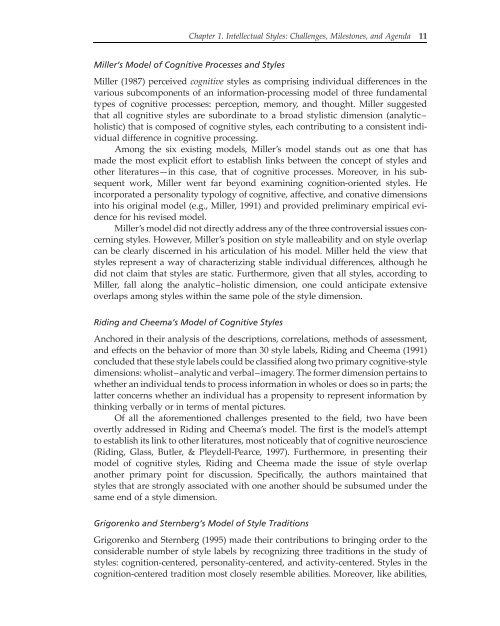Handbook of Intellectual Styles - Springer Publishing
Handbook of Intellectual Styles - Springer Publishing
Handbook of Intellectual Styles - Springer Publishing
You also want an ePaper? Increase the reach of your titles
YUMPU automatically turns print PDFs into web optimized ePapers that Google loves.
Chapter 1. <strong>Intellectual</strong> <strong>Styles</strong>: Challenges, Milestones, and Agenda 11<br />
Miller’s Model <strong>of</strong> Cognitive Processes and <strong>Styles</strong><br />
Miller (1987) perceived cognitive styles as comprising individual differences in the<br />
various subcomponents <strong>of</strong> an information-processing model <strong>of</strong> three fundamental<br />
types <strong>of</strong> cognitive processes: perception, memory, and thought. Miller suggested<br />
that all cognitive styles are subordinate to a broad stylistic dimension (analytic–<br />
holistic) that is composed <strong>of</strong> cognitive styles, each contributing to a consistent individual<br />
difference in cognitive processing.<br />
Among the six existing models, Miller’s model stands out as one that has<br />
made the most explicit effort to establish links between the concept <strong>of</strong> styles and<br />
other literatures—in this case, that <strong>of</strong> cognitive processes. Moreover, in his subsequent<br />
work, Miller went far beyond examining cognition-oriented styles. He<br />
incorporated a personality typology <strong>of</strong> cognitive, affective, and conative dimensions<br />
into his original model (e.g., Miller, 1991) and provided preliminary empirical evidence<br />
for his revised model.<br />
Miller’s model did not directly address any <strong>of</strong> the three controversial issues concerning<br />
styles. However, Miller’s position on style malleability and on style overlap<br />
can be clearly discerned in his articulation <strong>of</strong> his model. Miller held the view that<br />
styles represent a way <strong>of</strong> characterizing stable individual differences, although he<br />
did not claim that styles are static. Furthermore, given that all styles, according to<br />
Miller, fall along the analytic–holistic dimension, one could anticipate extensive<br />
overlaps among styles within the same pole <strong>of</strong> the style dimension.<br />
Riding and Cheema’s Model <strong>of</strong> Cognitive <strong>Styles</strong><br />
Anchored in their analysis <strong>of</strong> the descriptions, correlations, methods <strong>of</strong> assessment,<br />
and effects on the behavior <strong>of</strong> more than 30 style labels, Riding and Cheema (1991)<br />
concluded that these style labels could be classified along two primary cognitive-style<br />
dimensions: wholist–analytic and verbal–imagery. The former dimension pertains to<br />
whether an individual tends to process information in wholes or does so in parts; the<br />
latter concerns whether an individual has a propensity to represent information by<br />
thinking verbally or in terms <strong>of</strong> mental pictures.<br />
Of all the aforementioned challenges presented to the field, two have been<br />
overtly addressed in Riding and Cheema’s model. The first is the model’s attempt<br />
to establish its link to other literatures, most noticeably that <strong>of</strong> cognitive neuroscience<br />
(Riding, Glass, Butler, & Pleydell-Pearce, 1997). Furthermore, in presenting their<br />
model <strong>of</strong> cognitive styles, Riding and Cheema made the issue <strong>of</strong> style overlap<br />
another primary point for discussion. Specifically, the authors maintained that<br />
styles that are strongly associated with one another should be subsumed under the<br />
same end <strong>of</strong> a style dimension.<br />
Grigorenko and Sternberg’s Model <strong>of</strong> Style Traditions<br />
Grigorenko and Sternberg (1995) made their contributions to bringing order to the<br />
considerable number <strong>of</strong> style labels by recognizing three traditions in the study <strong>of</strong><br />
styles: cognition-centered, personality-centered, and activity-centered. <strong>Styles</strong> in the<br />
cognition-centered tradition most closely resemble abilities. Moreover, like abilities,

















